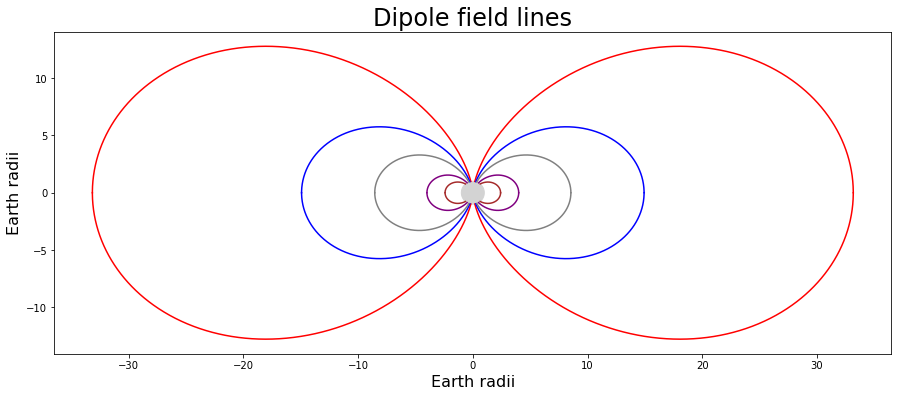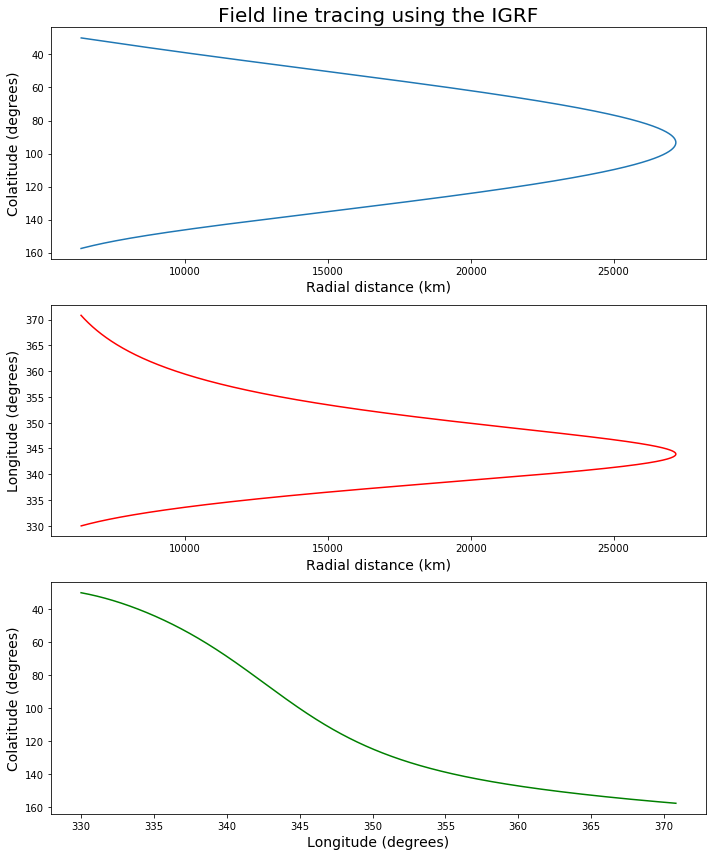Tracing magnetic field lines¶
Tracing magnetic field lines¶
The basic principle in following a field line at a point is to calculate the field vector there, then ‘take a step’ in the direction of the field to a new point, and repeat. The smaller the step, the higher the accuracy. This can be expressed as
with k a constant to scale the step size. We will use this to investigate the path of field lines computed using the IGRF, but first explore the simpler case of axisymmetric fields, where an explicit formula can be derived, avoiding the need for the ‘stepping strategy’.
Axisymmetric multipole field lines¶
In this case there is no variation with longitude (ϕ), so that
using spherical coordinates, which gives the equation of the field line as
This equation can be solved when the field is expressed in terms of spherical harmonics for the axisymmetric terms with m=0. In a spherical harmonic expansion, the zonal terms Pon correspond to axial multipoles, (P01 is a dipole, P02 is a quadrupole, P03 is an octupole and P04 is an hexadecapole.) The field line equation for P0n is (Willis and Young, 1987; Jeffreys, 1988)
Note the power of spherical harmonic degree n, and that the Associated Legendre polynomial in the equation has m=1 not m=0. For the field line that passes through a given starting position (r0, θ0),
from which an expression for the scaling factor in the first equation
is derived.
The (un-normalised) forms of P1n for n=1,…4 are
These, along with the expression for k, are used in the functions below to compute values of rn for n=1,…4.
def dipole(r0, theta_0, th): # P(n=1, m=0)
k = r0/(np.sin(theta_0)**2)
return (k*np.sin(th)**2)
def quadpole(r0, theta_0, th): # P(n=2, m=0)
k = r0**2/(np.sin(theta_0)**2*np.cos(theta_0))
P = np.cos(th)*np.sin(th)**2
return (np.sqrt(np.abs(k)*np.abs(P)))
def octpole(r0, theta_0, th): # P(n=3, m=0)
k = r0**3/(np.sin(theta_0)**2*(5*np.cos(theta_0)**2-1))
P = (5*np.cos(th)**2-1)*np.sin(th)**2
return ((np.abs(k)*np.abs(P))**(1/3))
def hexdpole(r0, theta_0, th): # P(n=4, m=0)
k = r0**4/((7*np.cos(theta_0)**3-3*np.cos(theta_0))*np.sin(theta_0)**2)
P =(7*np.cos(th)**3-3*np.cos(th))*np.sin(th)**2
return ((np.abs(k)*np.abs(P))**(1/4))
You can plot dipole, quadrupole, octupole and hexadecapole field lines using the code below. Start by choosing the type of multipole field lines to plot by setting the value of pole_type to the desired spherical harmonic degree n, where n=1,…4, and also setting some values of starting colatitude θ0 in the list theta. The program will draw the field lines passing through the point on the Earth’s surface at each value of colatitude (represented as radius=1 so the axes are scaled in Earth radii). Different choices of colatitudes may be more illuminating in different cases.
>> USER INPUT HERE: Set the plotting parameters below (pole type and starting colatitudes)¶
pole_type options:
1 = dipole
2 = quadrupole
3 = octupole
4 = hexadecapole
Now create the plot.
d2r = np.deg2rad
axpoles = {1:dipole, 2:quadpole, 3:octpole, 4:hexdpole}
names = {1:'Dipole', 2:'Quadrupole', 3:'Octupole', 4:'Hexadecapole'}
clines = ['red', 'blue', 'grey', 'purple', 'brown', 'purple', 'pink', 'orange', 'magenta', 'olive', 'cyan']
# Define the "Earth"
r0 = 1
the = d2r(np.linspace(0, 360, 1000))
xe = r0*np.sin(the)
ye = r0*np.cos(the)
fig, ax = plt.subplots(figsize=(15, 15))
ax.set_aspect('equal')
ax.fill(xe, ye, color='lightgrey') # Plot the Earth
ic = -1
for i in theta:
ic += 1
theta_0 = d2r(i)
th = np.linspace(theta_0, d2r(90), 1000)
rad = axpoles[pole_type](r0, theta_0, th)
xb = rad*np.sin(th)
yb = rad*np.cos(th)
xb[np.where(rad<1)] = np.nan
yb[np.where(rad<1)] = np.nan
ax.plot(xb, yb, color = clines[ic%10])
# Assume a symmetrical distribution in the four quadrants
ax.plot( xb, -yb, color = clines[ic%10])
ax.plot(-xb, yb, color = clines[ic%10])
ax.plot(-xb, -yb, color = clines[ic%10])
ax.set_xlabel('Earth radii', fontsize=16)
ax.set_ylabel('Earth radii', fontsize=16)
ax.set_title(names[pole_type]+' field lines', fontsize=24);

References¶
Jeffreys, B. (1988) ‘Derivations of the equation for the field lines of an axisymmetric multipole’, Geophysical Journal International. John Wiley & Sons, Ltd (10.1111), 92(2), pp. 355–356. doi: 10.1111/j.1365-246X.1988.tb01148.x.
Willis, D. M. and Young, L. R. (1987) ‘Equation for the field lines of an axisymmetric magnetic multipole’, Geophysical Journal International. Oxford University Press, 89(3), pp. 1011–1022. doi: 10.1111/j.1365-246X.1987.tb05206.x.
Using the IGRF to trace field lines (and find conjugate points)¶
The IGRF gives a fuller 3-D representation of the geomagnetic field, rather than the axisymmetric 2-D representation used above, and so the ‘stepping strategy’ is needed to follow field lines. The dipole field dominates, as we would expect, but it is interesting to to see how the colatitude and longitude change along the path. The starting and ending points at the Earth’s surface are ‘connected’ by a field line - they are conjugate points. (The IGRF for 2015.0 is used in the code below.)
>> >> USER INPUT HERE: Set the input parameters (listed below)¶
Starting colatitude (degrees)
Starting longitude (degrees)
Step size (km)
Now do the calculation and plot the results. *** This may take a few seconds - be patient! ***
d2r = np.deg2rad
r2d = np.rad2deg
fcalc = lambda x: np.sqrt(np.dot(x,x))
igrf12 = pd.read_csv(IGRF12_FILE, delim_whitespace=True, header=3)
gh2015 = np.append(0., igrf12['2015.0'])
NMAX = 13
# Initialise variables at starting point
r0 = 6371.2
thrd = d2r(theta_0)
phrd = d2r(phi_0)
track = [(r0, thrd, phrd)] # Store coordinates of points on the field line
bxyz = sha.shm_calculator(gh2015, NMAX, r0, theta_0, phi_0, 'Geocentric')
eff = fcalc(bxyz)
lamb = step_size/eff
rad = r0
# Allow a maximum number of steps in the iteration for the field line to
# return to the Earth's surface
maxstep = 10000
newrad = r0+0.001
step = 0
while step <= maxstep and newrad >= r0:
rad, th, ph = track[step]
lx, ly, lz = tuple(el*lamb for el in bxyz)
newrad = rad+lz
newth = th+lx/rad
newph = ph-ly/(rad*np.sin(th))
track += [(newrad, newth, newph)]
bxyz = sha.shm_calculator(gh2015, NMAX, newrad, r2d(newth), \
r2d(newph),'Geocentric')
lamb = step_size/fcalc(bxyz)
step += 1
rads = np.array([r[0] for r in track])
ths = np.array([t[1] for t in track])
phs = np.array([p[2] for p in track])
fig, (ax0, ax1, ax2) = plt.subplots(nrows=3, ncols=1, figsize=(10, 12))
ax0.plot(rads, r2d(ths))
ax0.invert_yaxis()
ax0.set_xlabel('Radial distance (km)', fontsize=14)
ax0.set_ylabel('Colatitude (degrees)', fontsize=14)
ax0.set_title('Field line tracing using the IGRF', fontsize=20)
ax1.plot(rads, r2d(phs), color='red')
ax1.set_xlabel('Radial distance (km)', fontsize=14)
ax1.set_ylabel('Longitude (degrees)', fontsize=14)
ax2.plot(r2d(phs), r2d(ths), color='green')
ax2.set_xlabel('Longitude (degrees)', fontsize=14)
ax2.set_ylabel('Colatitude (degrees)', fontsize=14)
ax2.invert_yaxis()
fig.tight_layout()

print('\nCoordinates of the starting point:')
print('\tColatitude :', '{0:.1f}'.format(theta_0), 'degrees')
print('\tLongitude :', '{0:.1f}'.format(phi_0), 'degrees')
print('\nCoordinates of the conjugate point:')
print('\tColatitude :', '{0:.1f}'.format(r2d(newth)), 'degrees')
print('\tLongitude :', '{0:.1f}'.format(r2d(newph)%360), 'degrees')